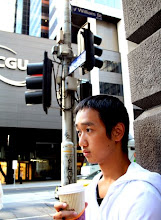Fiona Hall's Paradisus Terestris is made from aluminum and steel. It depicts the intersection of plant and human culture. Within each half-opened can sits a naked human body part, while plant life sprouts above. Beneath these top two layers, Hall adds language. The three systems make us consider what we share with plants. In 1989, she developed the series using photographic resources at the Australia Council's studio in New York's SoHo district.
TraceyMoffat creates a photographic narrative which use theatrical props in a comic (and sometimes grotesque) vein, yielding evocative dramas in the desert, the suburbs and historical fantasy. In the case of Moffat's Something More, it seeks to depart from an outback shack inhabited by rough types, only to enter into a sadistic lesbian relationship, ending in death. This was made from Cibachrome, extedning 98 × 127cm.
Rosalie Gascoigne's Printed Circuit is made from retro reflective roadsign on wood, meauring at 96 × 95cm. Her work has an ability to draw creative inspiration from the discarded; her intrinsic response to her chosen materials, and her unique ability to evocatively convey the essence of nature and the transitory and captivating effects of light, air and space.
http://www.cultureandrecreation.gov.au/articles/fionahall/
http://www.theage.com.au/articles/2004/01/13/1073877810745.html
http://www.australianbiography.gov.au/subjects/gascoigne/
http://www.ngv.vic.gov.au/rosaliegascoigne/
Subscribe to:
Post Comments (Atom)


No comments:
Post a Comment